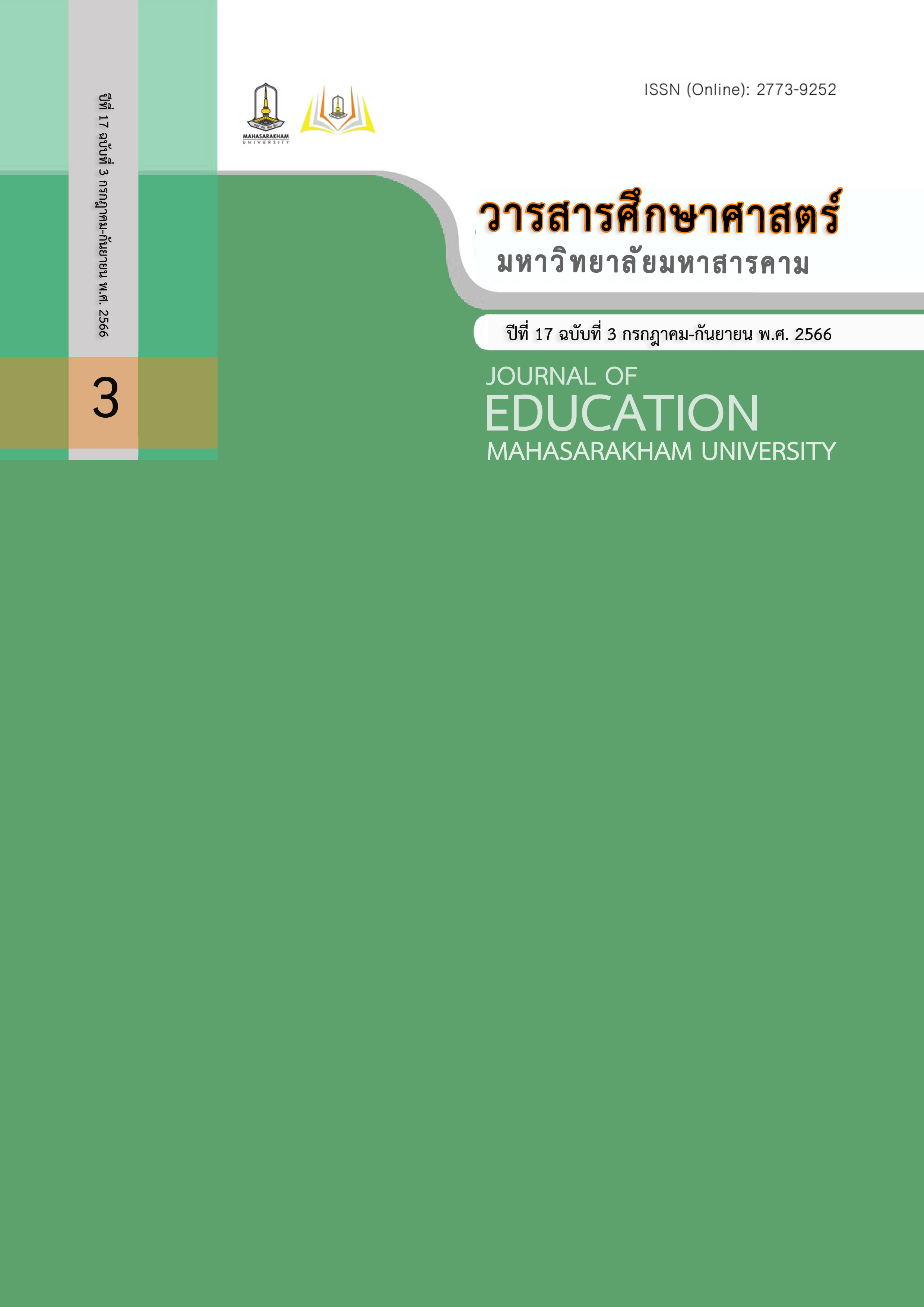The Development of Learning Activities Based on Engineering Design Process and Model-Based Learning in Earth and Geohazard Supporting Scientific Literacy for Grade 12 Students
Main Article Content
Abstract
The objectives of research were 1) to develop the learning activities based on engineering design process and model-based learning supporting scientific literacy, 2) to compare each scientific literacy of all 3 times, and 3) to compare learning achievements before and after employing the learning activities. The sample group used in the research was 37 numbers of the 12th grade students at Vichitraphittaya School, who were studying in semester 2 in the academic year 2022. They were randomly selected by using cluster random sampling. The research instruments consisted of: (1) three lesson plans of learning activities based on engineering design process and model-based learning with the IOC of 0.83-1.00, (2) the 15 items of scientific literacy test with the IOC of 0.73-1.00, and (3) the 30 items of learning achievement test with the correlation between 0.22-0.87, the reliability coefficient at 0.96, and the IOC of 0.93 - 1.00. The statistics used in data analysis were percentage, mean, standard deviation, t-test statistics and one-way repeated measures ANOVA.
The results showed that: 1. the quality evaluation results of the learning activities based on engineering design process and model-based learning in earth and geohazard supporting scientific literacy was at the highest level with an average of 4.64 and a standard deviation is 0.18 2. research findings on the scientific literacy of students studying the learning activities based on engineering design process and model-based learning for three times were significantly different at the .05 level. 3. the learning achievements of students studying the learning activities based on engineering design process and model-based learning was higher than before learning with the significance of .05
Downloads
Article Details

This work is licensed under a Creative Commons Attribution-NonCommercial-NoDerivatives 4.0 International License.
References
จารุนันท์ พาภักดี. (2563). การพัฒนาสมรรถนะการแปลความหมายข้อมูลและประจักษ์พยานในเชิงวิทยาศาสตร์ของนักเรียนชั้นมัธยมศึกษาปีที่ 5 ที่ได้รับการจัดการเรียนรู้แบบสืบเสาะที่ขับเคลื่อนด้วยกลวิธีการโต้แย้ง. วิทยานิพนธ์ปริญญาการศึกษามหาบัณฑิตมหาบัณฑิต, มหาวิทยาลัยสารคาม.
ชาตรี ฝ่ายคำตา. (2563). กลยุทธ์การจัดการเรียนรู้เคมี. กรุงเทพฯ: สำนักพิมพ์จุฬาลงกรณ์มหาวิทยาลัย.
นลพรรณ ไชยชนะ. (2564). ผลการจัดการเรียนรู้โดยใช้บริบทเป็นฐานร่วมกับเทคนิคการใช้คำถามที่ส่งผลต่อความสามารถในการอธิบายปรากฏการณ์ในเชิงวิทยาศาสตร์ของนักเรียนชั้นประถมศึกษาปีที่ 4. Journal of Graduate Research, 12(2), 31-44.
พิมพลอย ตามตระกูล. (2564). การพัฒนาความฉลาดรู้ด้านวิทยาศาสตร์ เรื่อง กรด -เบส ด้วยการจัดการเรียนรู้ แบบใช้บริบทเป็นฐานร่วมกับการใช้เทคโนโลยี สำหรับนักเรียนชั้นมัธยมศึกษาปีที่ 5. การค้นคว้าอิสระ การศึกษามหาบัณฑิตมหาบัณฑิต, มหาวิทยาลัยนเรศวร.
ณภัทร วอนศิริ. (2565). การพัฒนาสมรรถนะการแก้ปัญหาที่ซับซ้อนของนักเรียนชั้นมัธยมศึกษาปีที่ 3 ผ่านการจัดการเรียนรู้การออกแบบเชิงวิศวกรรมโดยใช้ปัญหาเป็นฐาน. Journal of Education Naresuan University, 24(3), 147-157.
ณภัทร สุขนฤเศรษฐกุล. (2564). การพัฒนาการด้านสมรรถนะในการนำเสนอตัวแทนความคิดของนักเรียนระดับชั้นมัธยมศึกษาปีที่ 6 ในหัวข้อเซลล์เคมีไฟฟ้า ผ่านการจัดการเรียนรู้โดยใช้แบบจำลองเป็นฐาน. Journal of Education Khon Kaen University, 44(4), 84-89.
ณัฐพล กวดไทย. (2563). การพัฒนาความสามารถในการสร้างแบบจำลองของนักเรียนชั้นมัธยมศึกษาปีที่ 4 รายวิชาชีววิทยา ด้วยการจัดการเรียนรู้โดยใช้แบบจำลองเป็นฐาน. วิทยานิพนธ์ปริญญาวิทยาศาสตรมหาบัณฑิต, มหาวิทยาลัยสารคาม.
ภพ เลาหไพบูลย์. (2552). แนวการสอนวิทยาศาสตร์. พิมพ์ครั้งที่ 8. กรุงเทพฯ: ไทยวัฒนาพานิช.
ลฎาภา ลดาชาติ. (2561). แบบจำลองกับการศึกษาวิทยาศาสตร์. Silpakorn University Journal, 38(4), 133-159.
ลือชา ลดาชาติ. (2561). การเรียนการสอนวิทยาศาสตร์ที่เป็นวิทยาศาสตร์ ประวัติศาสตร์ ปรัชญา และการศึกษา. กรุงเทพฯ: สำนักพิมพ์แห่งจุฬาลงกรณ์มหาวิทยาลัย.
ลือชา ลดาชาติ และลฎาภา ลดาชาติ. (2561). จากการรู้วิทยาศาสตร์และการสืบเสาะสู่สะเต็มศึกษาและการออกแบบ. Journal of Education Naresuan University, 20(1), 246-260.
ศรายุทธ รูปโฉม. (2564). การวิจัยปฏิบัติการเพื่อพัฒนาการจัดการเรียนรู้ เรื่อง กรด-เบส โดยใช้การจัดการเรียนรู้ผ่านกระบวนการออกแบบเชิงวิศวกรรม ตามแนวทางสะเต็มศึกษาที่ส่งเสริมทักษะการสร้างสรรค์และนวัตกรรมของนักเรียนระดับชั้นมัธยมศึกษาปีที่ 5. Journal of Education Naresuan University, 23(1), 308-320.
ศศิมน ศรีกุลวงค์. (2564). การใช้แบบจำลองและการสร้างคำอธิบายทางวิทยาศาสตร์ของนักเรียนชั้นมัธยมศึกษาปีที่ 2. CMU Journal of Education, 5(1), 12-27.
ศิรินนาถ ทับทิมใส. (2563). ผลการจัดการเรียนรู้วิทยาศาสตร์ เรื่อง พลังงานความร้อน ด้วยกระบวนการออกแบบเชิงวิศวกรรมที่มีต่อความคิดสร้างสรรค์ทางวิทยาศาสตร์และผลสัมฤทธิ์ทางการเรียนของนักเรียนชั้นมัธยมศึกษาปีที่ 1. วิทยานิพนธ์ปริญญาการศึกษามหาบัณฑิต, มหาวิทยาลัยศรีนครินทรวิโรฒ.
กระทรวงศึกษาธิการ. (2560). ตัวชี้วัดและสาระการเรียนรู้แกนกลาง กลุ่มสาระการเรียนรู้วิทยาศาสตร์ ตามหลักสูตรแกนกลางการศึกษาขั้นพื้นฐาน พุทธศักราช 2551 (ฉบับปรับปรุง พ.ศ. 2560). กรุงเทพฯ: ชุมนุมสหกรณ์การเกษตรแห่งประเทศไทย จำกัด.
สถาบันส่งเสริมการสอนวิทยาศาสตร์และเทคโนโลยี. (2560). คู่มือการใช้หลักสูตรรายวิชาพื้นฐานวิทยาศาสตร์ ระดับมัธยมศึกษาตอนปลาย กลุ่มสาระการเรียนรู้วิทยาศาสตร์ (ฉบับปรับปรุง พ.ศ. 2560) ตามหลักสูตรแกนกลางการศึกษาขั้นพื้นฐาน พุทธศักราช 2551. กรุงเทพฯ: ชุมนุมสหกรณ์การเกษตรแห่งประเทศไทย จำกัด.
สถาบันส่งเสริมการสอนวิทยาศาสตร์และเทคโนโลยี. (2564). ผลการประเมิน PISA 2018 การอ่านคณิตศาสตร์และวิทยาศาสตร์. กรุงเทพฯ: ชุมนุมสหกรณ์การเกษตรแห่งประเทศไทย จำกัด.
สุคนธ์ สินธพานนท์. (2553). นวัตกรรมการเรียนการสอนเพื่อพัฒนาคุณภาพของเยาวชน (ฉบับปรับปรุงครั้งที่ 2). พิมพ์ครั้งที่ 4. กรุงเทพฯ: 9119 เทคนิคพริ้นติ้ง.
สำนักงานเลขาธิการสภาการศึกษา. (2560). แผนการศึกษาแห่งชาติ พ.ศ. 2560-2579. กรุงเทพมหานคร: โรงพิมพ์พริกหวานกราฟฟิค.
อพันตรี พูลพุทธา. (2565). การวิจัยทางการศึกษา. ตักสิลาการพิมพ์.
อภิสิทธิ์ ธงไชย. (2559). ความสำคัญของวิศวกรรมในการจัดการเรียนรู้วิทยาศาสตร์ในศตวรรษที่ 21. Journal of Kasetsart Educational Review, 31(3), 48-53.
โรงเรียนวิจิตราพิทยา. (2564). รายงานผลการทดสอบทางการศึกษาระดับชาติขั้นพื้นฐานระดับชั้นมัธยมศึกษาปีที่ 6 โรงเรียนวิจิตราพิทยา ปีการศึกษา 2562-2564. อุบลราชธานี: โรงเรียน วิจิตราพิทยา.
Gobert, J. D. and B. C. Buckley. (2000). Introduction to model-based teaching and learning in science education. International Journal of Science Education, 22(9), 891-894.
Gilbert et al. Positioning Models in Science Education and in Design and Technology Education. In Developing Models in Science Education. Natherland: Kruwer academic publishers.
Institute for the Promotion of Teaching Science and Technology. (2015). Basic Knowledge about STEM Education. (online) 2015 (cited 20 August 2022). from http://www.stemedthailand.org/wp-content/uploads/2015/03/newIntro-to-STEM.pdf.
Johnson, C. C., Walton, J. B., and Peters–Burton, E. (2018). STEM Road Map for High School. Virginia: National Science Teacher Association.
Kelly, T. R., & Knowles, J. G. (2016). A Conceptual Framework for Integrated STEM Education. International Journal of STEM Education, 3(11), 1-11.
OECD. (2022). PISA 2018 Assessment and Analytical Framework. Paris: OECD Publishing, (online) 2019 (cited 20 August 2022). from https://doi.org/10.1787/ b25efab8-en.
Partnership for 21st Century Learning. (2019). FRAMEWORK FOR 21st CENTURY LEARNING DEFINITIONS. Battelle for kids.
Rea-Ramirez, M. A., Clement, J. and Nunez-Oviedo, M. C. (2008). An instructional model derived from model construction and criticism theory, In J. J. Clement & M. A. Rea-Ramirez (Eds.). Model Based Learning and Instruction in Science, Netherlands: Springer.
Wendell, K. B. and Rogers, C. (2013). Engineering Design-Based Science, Science Content Performance, and Science Attitudes in Elementary School. Journal of Engineering Education, 102(4), 513-540.

